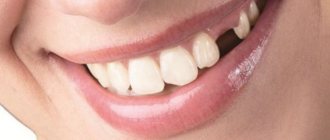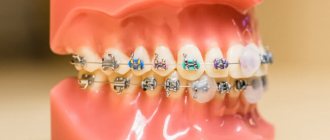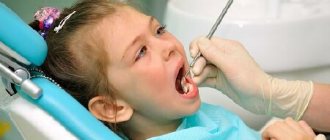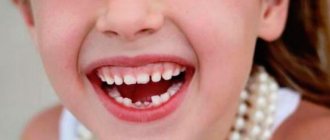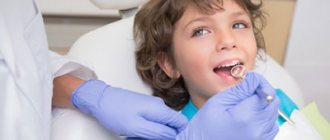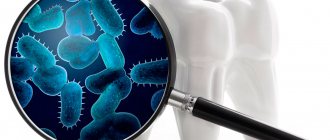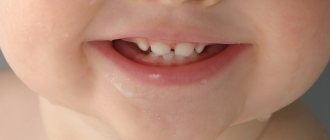DEVELOPMENT OF THE FACIAL SKELETON
Initially, the cutaneous ectoderm at the head end of the embryo thickens, invaginates into the underlying mesenchyme and grows towards the blind end of the foregut or gill. The resulting depression is called the oral fossa. It is formed by the end of the 3rd week of embryonic development. The bottom of the oral fossa is adjacent to the endoderm of the foregut and together with it forms the pharyngeal membrane. In the fourth week of development, the integrity of the pharyngeal membrane is broken, and the oral fossa already communicates with the initial part of the foregut.
Rice. 1. Longitudinal section through the head of a human embryo (diagram). The length of the embryo is 3 mm.
1-oral fossa; 2-pharyngeal membrane; 3-foregut; 4-chord
From the initial part of the foregut, the gill apparatus is formed, which takes part in the development of the oral cavity and face. The gill apparatus consists of five pairs of gill pouches and the same number of gill arches and slits.
Gill arches, which are roller-shaped thickenings of mesenchyme, are located between adjacent gill pouches and slits. The largest and most developed is the first (mandibular) gill arch, from which the rudiments of the upper and lower jaws subsequently develop.
At the early stages of development (end of the 1st month), the primary oral opening is surrounded by five embryonic tubercles (processes), which are outgrowths of the dorsal end of the first branchial arch. At the upper edge of the oral fissure there are two paired - right and left - maxillary tubercles. Between them is the unpaired frontal tubercle. The lower edge of the oral fissure is limited by two mandibular tubercles (Fig. 2).
Rice. 2. 4th week of embryogenesis.
1-frontal tubercle; 2-maxillary tubercles; 3-primary oral opening; 4-mandibular cusps
Soon, depressions appear in the lateral parts of the frontal buffalo - olfactory pits. Around the olfactory pits, horseshoe-shaped tissue elevations appear, which transform into two nasal processes - medial and lateral (Fig. 3).
Rice. 3. 5th week of embryogenesis.
1-frontal tubercle; 2-maxillary tubercles; 3-primary horny opening; 4- mandibular tubercles; 5-olfactory pits; 6-medal nasal processes;
7-lateral nasal processes
The middle part of the alveolar process of the upper jaw, where the incisors develop, the middle part of the upper lip, as well as the anterior part of the hard palate (primary palate), are formed as a result of the fusion of the medial nasal
Department of Pediatric Dentistry
processes, and the lateral parts of the upper jaw and upper lip - from the maxillary tuberosities. The upper lip fuses at 5-6 weeks of embryonic development (Fig. 4).
Rice. 4. 6th week of embryogenesis. The medial nasal processes have fused.
In human embryogenesis, there are cases of non-fusion of the maxillary tuberosities with the medial nasal processes. This leads to the formation of clefts of the upper lip, and sometimes of the alveolar process (Fig. 5,6).
Rice. 5. Congenital incomplete cleft of the upper lip on the left
Rice. 6. Congenital complete bilateral cleft of the upper lip and alveolar process.
Failure of fusion of the maxillary tuberosities with the mandibular tubercles in the lateral parts of the fetal face leads to the formation of transverse (Fig. 7) or oblique facial clefts. If the mandibular embryonic tubercles do not fuse together, then a cleft of the lower jaw and lower lip occurs along the midline, however, such congenital defects are very rare in the clinic.
Rice. 7. Congenital transverse facial cleft.
Rice. 8. 7th week of embryogenesis.
The fusion of the embryonic tubercles that form the face has been completed.
Rice. 9. The face of an embryo at the 12th week of development.
This is what the face of an embryo looks like at later stages of development (Fig. 8,9).
Formation of the dental system in the postnatal period.
Newborn period.
The distal and lingual relationship of the jaws in newborns is a physiological pattern, since the lower jaw is located slightly behind the upper jaw (up to 10 mm) and there is a vertical gap (2.5-2.7 mm). Apparently, during childbirth, this position of the lower jaw facilitates easier passage of the head and protects it from the possibility of injury. Functional load during sucking promotes more intensive growth of the lower jaw than the upper jaw. During the period of eruption of primary incisors (6-8 months), the jaw ratio is usually normalized, which is also due to the fact that the lower incisors erupt earlier and the alveolar process in this area grows more intensively. Period of temporary occlusion. The first stage - the developing temporary bite - begins at 6 months, i.e., from the period of eruption of temporary incisors and ends on average at 28-30 months. Their eruption before 4 months is considered premature, after 1 year - late. Both halves of the newborn's lower jaw are connected along the midline by fibrocartilage. After the first year of life, this suture ossifies, while ossification of the median palatal suture ends by age 25. When the first temporary molars erupt (1.5 years), the toothless areas of the jaws separate, on which temporary canines and second temporary molars will subsequently erupt; This is the first physiological increase in occlusion according to Schwartz. From 1.5 to 3 years, active growth of the jaws continues, which is associated with the eruption of the remaining temporary teeth, but its intensity decreases somewhat (see Fig. 2.4). Establishing a minimum incisal overlap in the temporary dentition is considered optimal. If the size of the crowns of the upper and lower primary molars corresponds and the dentition is correctly closed, there is a “mesial step”, then during eruption the first permanent molars will be established in the bite in a neutral relationship. If the crowns of the lower temporary molars are wider than the crowns of the upper ones by up to 2 mm, then the distal surfaces of the second temporary molars are installed in the same plane. During a clinical examination, it is difficult to determine the relationship of the distal surfaces of the second temporary molars and the difference in the size of the crowns of the upper and lower temporary molars. In these cases, the ratio of the upper and lower primary canines is assessed. Their correct ratio is a favorable sign for the development of normal occlusion, since the ratio of temporary canines before and after the eruption of the first permanent molars remains, as a rule, unchanged. When the difference in the sizes of the primary molars of the upper and lower jaws is more than 2 mm, a “distal step” appears between their distal surfaces. Its presence, as well as a slight incorrect relationship between the primary canines, are unfavorable prognostic signs for the formation of a normal bite. External factors have little impact on the localization of primary tooth primordia, so their abnormal location is observed relatively rarely.
The second stage is the formed temporary bite. From 3 to 4.5 years, the growth of the alveolar processes of the jaws still continues, as the formation of the roots of the lateral temporary teeth ends, but its intensity decreases significantly. After this, before the change of incisors begins, the dimensions of the dental arch change slightly. At the age of 4 to 6 years, there is practically no growth of the dentoalveolar arches and jaws. Temporary bite is formed of two types - with or without three. According to A.L. Vladislavov (1969), there are three types of temporary dental arches: 1) the presence of three between the front teeth (57%); 2) the presence of three (“three primates”) on the upper (33%) and lower (47%) jaws; 3) absence of teeth in the anterior section of both dental arches (21%). The absence of trema is an unfavorable prognostic sign and is a risk factor, since in the absence of trema, close arrangement of permanent teeth is 4 times more common. The period of mixed (mixed) dentition. Changeable bite is a clinical concept, not an anatomical one. It is observed in the second six-year period (6-1.2 years) of the formation of the dental system, during which the temporary teeth become loosened and are gradually replaced by permanent teeth. At the same time, the formation of the permanent begins. The same wave-like nature of the jaw growth process remains, depending on the development, growth and eruption of permanent teeth. The first stage - early mixed dentition is observed from 6 to 9 years. The most active growth of the jaws is observed in the first 1.5 years (6-7.5 years). It is caused by the eruption of the first permanent molars, when temporary teeth are replaced by permanent ones. As a result of the eruption of the first permanent molars, active growth of the jaws is observed and a second physiological increase in the bite occurs. Under the pressure of the lower jaw growing forward at the age of 6-7 years, mainly in the upper jaw, three spaces increase between the front temporary teeth, which contributes to an increase in the bite and the installation of erupting permanent incisors, larger in size than the milk ones, into the dentition.
As a rule, four options are observed for the eruption and correct installation of the first permanent molars in the bite: 1. If there is a medial step between the distal surfaces of the second temporary molars, the first permanent molars are immediately installed correctly (at 6 years). 2. The closure of the second temporary molars in one plane leads to the establishment of 6 teeth in the cuspal closure. The improvement of their ratio will further depend on the presence of three between the teeth, the abrasion of the cusps of temporary teeth and interdental contacts on the proximal surfaces of their crowns, when mesial displacement occurs under the pressure of 6 teeth, especially the lower temporary molars (at 7-7.5 years) . 3. In the presence of large jaws with or without three gaps between the temporary teeth, despite the closure of the second primary molars behind in the same plane, the first permanent molars can erupt and immediately establish themselves correctly. 4. In the presence of small jaws (“rudimentary” variant), absence of three, closure of the second temporary molars in one plane, the cusp closure of the first permanent molars can persist for a long time (from 6 to 12 years), i.e. there is a risk factor for the formation of distal - bite. After changing the temporary molars of premolars, excess space appears due to the difference in the sizes of the crowns of temporary and permanent teeth, which is necessary to correct the position of the sixth teeth.
Under the pressure of the primordia of permanent incisors, the roots of temporary incisors are resorbed, and the crowns of permanent incisors are displaced anteriorly. This causes increased appositional growth and bone deposition on the vestibular surface of the alveolar process. The permanent incisors erupt with a vestibular inclination of the crowns in relation to the basal arch of the jaw and are located in the dental arch. Retention of a temporary tooth in the dental arch is a diagnostic sign of impaired eruption of a permanent tooth, its retention, abnormal location of the bud, adentia and other pathology. Mineralization of teeth is a specific process that reflects the stages of formation of the dentofacial system and the level of ossification of the skeleton. One of the methods for studying the formation of teeth is orthopantomography of the jaws. When studying teeth on orthopantomograms, eight stages of their mineralization are distinguished: I - the appearance of the bone shell of the tooth follicle, II - mineralization of the cutting edge or cusps of the tooth, III - half the height of the crown, IV - the crown of the tooth, V - the root of the tooth at one-fifth of its length, VI - 2/3 of the length, VII - the entire length, VIII - closing the root apex (Fig. 2.5).
Rice. 2.5. Stages (I-VIII) of the formation of crowns and roots of permanent teeth. a - single-rooted tooth; b - two- and three-rooted teeth.
The boundaries of mineralization of permanent teeth are shown in Fig. 2.6. They correspond to the age at which this stage of mineralization was observed in more than 80% of cases [Khoroshilkina F. Ya., Tochilina T. A., 1978]. In girls, mineralization of teeth occurs faster than in boys. The rate of tooth eruption varies in each group, but there is significant individual variation. The second molars erupt faster than others.
Rice. 2.6. Stages of formation of permanent teeth with a neutral mixed dentition in boys (left) and girls (right) aged 6-11 years (according to Tochilina). Arabic numerals indicate age (years), Roman numerals indicate the stages of tooth formation.
An erupting tooth is under the influence of a functional load - pressure from the lips, cheeks, tongue, which affects the formation of the dentition. If the erupting teeth are in a zone of balanced muscle pressure, i.e. equal pressure of the lips and cheeks on one side and the tongue on the other, then the dental arches are formed correctly (the upper one is in the form of a semi-ellipse, the lower one is a parabola). If the pressure of the tongue prevails, then the teeth shift in the vestibular direction during eruption, which also affects the formation of the alveolar process. The second stage is late mixed dentition (9-12 years). At the age of 9, the second late stage of tooth change begins, when in 18 months 12 temporary teeth are replaced by permanent ones. The growth of the jaw body slows down significantly; active growth of the alveolar processes is noted, due to the completion of the formation of the roots of the incisors and first permanent molars, as well as the replacement of canines and the eruption of premolars (Fig. 2.7).
Rice. 2.7. Replacement of lateral temporary teeth with permanent ones according to Bauma. 1 - relationship of the first permanent molars; 2 - change in the position of the teeth after replacing the first primary molar with a permanent premolar; 3 - secondary mesial displacement of teeth in the lower jaw; 4 - mesial movement of the lower first permanent molar and growth in the anterior part of the dental arch.
The order of teeth replacement is especially important in the fourth (“rudimentary”) variant of the formation of a normal bite. On the upper jaw, the first premolars erupt first (9 years), then the canines and second premolars, often simultaneously (10-11 years). In this case, the upper canines take up excess space, moving distally. On the lower jaw, the canines erupt first (9 years), then the first premolars (Shlet) and second premolars (11 years). Under pressure from the lower canines, the lower incisors move forward and the bite increases, and when primary molars are replaced by premolars, the lower first molars can freely take up excess space, moving mesially. This ensures correct bite. Thus, the third physiological increase in occlusion is associated with the eruption of permanent canines, and not the second permanent molars, as previously thought. Period of permanent occlusion. The formation of a permanent bite begins at 6 years of age. The conditional boundary between the replaceable (mixed) and permanent dentition can be considered the stage of formation of the dental system, when there is no longer a single temporary tooth left. This precedes or coincides with the eruption of the second permanent molars.
The first stage is the developing permanent dentition from 12 to 18 years of age. In the third six-year period, the eruption of the second and third permanent molars occurs, accompanied by active growth of the alveolar processes of the jaws for another 8 teeth. There is also a wave-like process of jaw growth, especially active in the first 1.5 years (12-13.5 years), slowing down in the next 1.5 years (13.5-15 years), subsiding by 16.5 years and practically absent in aged from 16.5 to 18 years. This growth significantly depends on the eruption of 7 teeth, the formation of the roots of the canines, second premolars and molars. The second stage is the “pre-forming” (Yu. M. Malygin) permanent dentition (from 18 to 24 years). The alveolar process is a formation genetically associated with the formation and eruption of teeth. With edentia, the alveolar process does not form; after tooth loss, it atrophies. In the fourth six-year period, the jaws reach their maximum length during the eruption of the third permanent molars, i.e. after 18 years. The absence of these teeth in the dentition at the age of 21 in the presence of rudiments or their vestibular eruption indicates insufficient growth of the jaws in length. Active teething continues along with their mesial movement, occurring in the direction of masticatory pressure forces.
The third stage is the formed permanent bite. With the establishment of permanent teeth in the occlusion, the processes of bone formation and restructuring slow down, but do not stop. Mesial movement of teeth continues throughout a person’s life as their contacting lateral surfaces wear away. The space occupied by the teeth in the dentition and the local length of the dental arches decrease, while the total length of the dental arches increases due to the eruption of the second and then third molars. After the completion of organogenesis during fetal development, the postnatal period and the formation of a permanent dentition, growth of the dentoalveolar system occurs, as a result of which the size of the jaw bones increases in three mutually perpendicular directions. The total forward movement is 20 mm in 20 years, i.e. an average of 1 mm per year. From the age of 6.5 years to adulthood, the shape of the occlusal surface of the dentition, articular heads and articular fossae changes due to increasing functional load. The spherical shape of the occlusal surface of the dentition is most appropriate for absorbing the chewing load and transferring it to the base of the jaw bones. Differences in the shape and size of the upper and lower jaws are the result of their mutual adaptation [Busygin A. T., 1962]. Growth and teething significantly affect the change in facial height, which increases with the eruption of primary teeth - by 17%, first permanent molars and subsequent teeth - by 14%, second permanent molars - by 24%. This totals 55% [Eismann D., 1965]. The proportions of the face and its external shape change as the bones of the facial skeleton shift relative to each other. However, this does not lead to disproportion. Constancy of form and preservation of individual appearance is ensured by remodeling growth, i.e., a genetically controlled process of growth in all zones (articular, suture, appositional) at different times, with unequal intensity and in different directions.
DEVELOPMENT OF THE ORAL CAVITY
On the inner surface of the maxillary tuberosities, lamellar palatine processes appear, which, fused together along the midline, form most of the palate. In the anterior section they merge with the primary palate, formed from the frontal tubercle. This occurs at 6-8 weeks of embryonic development. If the palatine processes do not fuse together, the newborn has a cleft of the hard and soft palate (Fig. 10).
Fig. 10. Congenital left-sided cleft palate, combined with a cleft of the alveolar process and upper lip.
At the seventh week of embryogenesis, the stratified squamous epithelium of the oral fossa begins to grow along the upper and lower edges of the primary oral cavity and sink into the underlying mesenchyme. The so-called buccal-labial (or vestibular) plate of an arcuate shape is formed. A gap appears in the plate, which subsequently transforms into the vestibule of the oral cavity.
Language develops from several rudiments. In an embryo 5 mm long, in the middle part of the posterior edge of the first gill arch, an unpaired tubercle first appears, along the edges of which 2 lateral tubercles are formed. The anterior part of the back of the tongue develops from the unpaired tubercle, and most of the body of the tongue and its apex develop from the paired ones. The posterior section of the tongue is formed separately, in the form of paired projections on the inner surface of the second and third pairs of gill arches. The muscles of the tongue develop from the myotomes of the upper primary segments. At the eighth week of embryogenesis, the development of the tongue is basically completed, the tongue is already covered with multilayered epithelium, and this organ already has its final shape.
Orthodontics Clinic
Patterns of development and growth of the dental system
Orthodontic dentistry is not only about correcting the position of teeth, but also about controlling jaw growth, correcting the shape of the facial skeleton, normalizing the functions of the dental system and restoring optimal facial aesthetics.
Prenatal period
The growth and development of the jaws is closely related to the formation of teeth, the alveolar process and is subject to the general development of the entire organism under the influence of endo and exogenous factors. At the 7th week of pregnancy, the baby begins to separate the oral cavity from the nasal cavity. It is during this period that the development of the fetal dental system can be adversely affected by endogenous factors of the mother - toxicosis, disturbances of hormonal regulation, water-salt and vitamin metabolism, exogenous influences, which can lead to nonunion of the upper lip, alveolar process and palate. During the period of intrauterine development, the alveolar process of a child grows by 55% of its future size, and over the next 24 years after birth by only 45%. This growth process occurs in waves, in impulses, with alternating periods of acceleration and deceleration of bone tissue formation. Therefore, when consulting a patient in the clinic, we realize that these nine months of intrauterine development are a little-known period for finding out the exact cause of the formation of an abnormal bite.
Newborn period
During the newborn period, the child experiences so-called infantile retrogenia (the lower jaw is displaced back in relation to the upper jaw), the sagittal gap between the jaws ranges from 5 to 10 mm. This is a physiological norm. Functional load during feeding (6 times a day for 30 minutes) promotes muscle training and growth of the lower jaw, which leads to normalization of the jaw ratio. Artificial feeding, in which the child receives milk quickly and in large quantities, does not contribute to the necessary load, leading to retarded growth of the lower jaw and the formation of a distal bite. If the growth of the lower jaw does not occur in the first year of the child’s life, then this lag will be observed from year to year, which will subsequently require long-term orthodontic treatment from 2 to 5 years.
Period of temporary occlusion
During the period of temporary occlusion from 7 months to 3 years, the most active growth of the child and dentoalveolar arches is observed. During the period of formed temporary occlusion from 3 to 6 years, sagittal growth stops and transversal growth of the jaws is noted, which leads to the appearance of three (gaps) between the teeth. In the absence of three, the crowded position of the anterior teeth occurs on the upper jaw in 62.5% of cases, on the lower jaw in 79%.
Period of early mixed dentition
During the period of mixed dentition, from the age of 6 years, a powerful impulse of jaw growth is associated with the eruption of incisors and first molars. The rudiments of these teeth move vestibularly and toward occlusion, subjected to pressure from the lips, cheeks, and tongue, leading to automatic restructuring of bone tissue and an increase in the distance between the primary canines. Violation of the myo-functional balance during teething due to improper breathing, chewing, swallowing, and speech leads to underdevelopment of the alveolar process and the appearance of crowding of the anterior teeth. It is known that a force of 1.7 grams is sufficient to displace the lower frontal teeth lingually with the lower lip. With myofunctional disorders, the lower lip can exert a pressure of 100-300 g on the front teeth of the lower jaw, and a pressure of 500 g on the tongue, which leads to the formation of malocclusion. Therefore, to eliminate functional disorders during this period, functional equipment, for example, a Frenkel apparatus or a lip bumper, is most effective. Considering that the frontal area of the lower jaw in an adult and a child after the eruption of the incisors has a constant size, great importance must be attached to the development of this area from 6 to 8 years, where all dental aesthetics are concentrated. An attempt to increase the lower dentition in the anterior section after 9-11 years leads to relapse. The correct position of the lower incisors at the age of 7-9 years contributes to the increase in the upper dentition in the frontal region, which prevents the appearance of a crowded position of the incisors in the upper jaw.
Period of late mixed and permanent dentition
In the final period of the mixed dentition, from the age of 9, there is no active growth of the jaws, so very important importance must be attached to the sequential change of teeth:
- Lower jaw - normally, the canines, first and second premolars change sequentially, the first molars can move mesially. Under the pressure of the lower canines, the frontal area moves forward and the bite increases.
- Upper jaw - first premolars, canines, second premolars, canines move distally.
The period of permanent dentition is characterized by active growth of the dentoalveolar arches, associated with the eruption of second and third molars. The beginning of mineralization of the cusps of the third molars is observed at 7-8 years; by the age of 9-13 years, the rudiments of these teeth are already revealed on the orthopantomogram.
Peaks of growth
During the formation of the dental system, the following growth peaks are observed:
- At 3-6 years old.
- At 6-7 years old in girls and 7-9 years old in boys and is associated with the eruption of incisors and molars
- At 9 years old in girls and 11 years old in boys and is associated with the change of 3,4,5 teeth.
- At 11-13 years of age in girls and 13-15 years of age in boys, it is associated with puberty and the eruption of second molars.
According to scientific research, at 11 years of age, the lower jaw can normally grow in the sagittal direction to approximately 3 mm per year, and at 14 years, up to 5.5 mm. The use of functional equipment at this age stimulates the growth of the lower jaw by 1.5 mm more than normal. From this we can conclude that the effect of functional equipment should not be overestimated during these periods of formation of the dental system; it is necessary to understand that in order to correct the pathology of occlusion in the sagittal direction, it is necessary, first of all, to create conditions for the physiological growth of the lower jaw, eliminating all adverse effects. A very good treatment result can be obtained by correcting the bite at the age of 6-8 years, during the period of eruption of the frontal teeth, when using functional equipment the pressure of the lower lip is eliminated, the teeth and lower jaw physiologically move in the anterior direction.
ODONTOGENESIS
Odontogenesis - tooth development - begins at the 6th week of embryogenesis, when the follicles of baby teeth are formed, and is sometimes completely completed after 20 years, when the third permanent molars erupt and the formation of their roots ends.
Human teeth develop from components of the oral mucosa of the embryo. Its epithelium gives rise to the structural elements involved in the formation of enamel, and the mesenchyme is the source of dentin, pulp and cement.
In the development of each tooth, 3 periods are distinguished: the formation of dental germs, their differentiation and histogenesis - i.e. development of basic tooth tissues (enamel, dentin, pulp, cement).
STACKING DENTALS
First, in the area of the future anterior teeth, a dental plate originates from the vestibular plate at a right angle and grows into the underlying mesenchyme. During their growth, the epithelial dental plates take the form of two arches located in the mesenchyme of the upper and lower jaws.
Then, along the free edge of the plate on the anterior (buccal-labial) side, flask-shaped protrusions of the epithelium (10 in each jaw) are formed - tooth buds (gemmae dentis). At 9-10 weeks of embryonic development, mesenchyme begins to grow into them, giving rise to dental papillae (papillae dentis). As a result, the dental bud takes the shape of a bell or bowl, transforming into an epithelial dental organ (organum dentale epitheliale). Its inner surface, bordering the mesenchyme, bends in a peculiar way and the outlines of the dental papilla gradually take on the shape of the future tooth crown. By the end of the 3rd month of embryogenesis, the epithelial dental organ is connected to the dental plate only by a narrow epithelial cord—the neck of the dental organ.
Around the epithelial dental organ and under the base of the dental papilla, a thickening of mesenchyme is formed - the dental sac (sacculus dentis) (Fig. 11).
Fig. 11. Scheme of development of tooth germs (according to Falin).
1-edge of the lower jaw; 2-tooth plate; 3-buccolabial groove; 4-lip;
5-enamel organ; 6-dental papilla; 7-neck of the enamel organ; 8 tooth buds
Thus, in the formed dental germ, three parts can be distinguished: the epithelial dental organ, the mesenchymal dental papilla and the dental sac. This marks the end of stage 1 of tooth development—the stage of formation of tooth germs—and the period of their differentiation begins.
DIFFERENTIATION OF DENTAL RUGS
First, the dental organ is divided into several cellular layers. In its central part, a protein fluid accumulates between the cells, pushing them apart. These cells acquire a stellate shape, and their combination forms the pulp of the dental organ (pulpa organi dentis). The cells of the dental organ adjacent to the surface of the dental papilla become cylindrical and are called the internal dental epithelium (epithelium dentale internum). These cells give rise to enameloblasts, which are involved in the formation of tooth enamel.
Between the anameloblasts and the pulp of the dental organ there are several rows of flat or cubic cells that form the intermediate layer of the dental organ (stratum intermedium). The outer surface of the dental organ is formed by flattened cells of the outer dental epithelium (epithelium dentis externum) (Fig. 12).
Fig. 12. Enamel organ.
1-tooth plate; 2-neck; 3-outer epithelium; 4-pulp of the enamel organ
5-internal epithelium; 6-odontoblasts; 7-dental papilla; 8-membrane;
9 tooth pouch
Subsequently, the cells of the outer dental epithelium gradually atrophy, and the cells of the intermediate layer of the enamel organ and its pulp take part in the formation of the enamel cuticle.
So, as a result of the differentiation of the dental organ, it is already possible to distinguish its pulp, internal and external dental epithelium and the intermediate layer. The dental papilla is then differentiated. By this time, it increases in size and penetrates deeper into the dental organ. Blood vessels and nerve fibers penetrate the base of the dental papilla, growing towards its apex. On the surface of the mesenchymal dental papilla, several rows of densely located cells are formed - preodontoblasts, which later give rise to cells with basophilic cytoplasm - odontoblasts (dentin-forming cells). First they form at the top of the dental papilla, later - on its lateral surfaces. The layer of odontoblasts is adjacent to the inner dental epithelium (enameloblasts), separated from it by a thin basement membrane.
By the end of the 3rd month of intrauterine development, due to the proliferation of mesenchyme, the tooth germs separate from the dental plate, it loses contact with the epithelium of the oral cavity and is partially resorbed. Only the deep sections of the dental plates, which give rise to the rudiments of permanent teeth, are preserved and grow.
Congenital malformations of the face, jaws and teeth
Congenital diseases are all deviations from normal development detected at the birth of a child. They may be called developmental anomalies, which are characterized by a deviation from the norm that is not accompanied by functional impairment; and developmental defects with a pronounced deviation in the anatomical structure, accompanied by dysfunction.
From a deontological point of view, the correct definition would be “congenital malformation” indicating the specific area of the lesion, for example “congenital incomplete cleft of the upper lip on the right.”
According to their pathogenesis, congenital diseases are divided into hereditary diseases and hereditarily predisposed diseases, which are caused by damage to the hereditary apparatus of the reproductive or somatic cell.
In addition, the group of congenital malformations includes non-hereditary teratogenic diseases that developed at different stages of embryogenesis under the influence of stimuli from the external and internal environment.
Currently, over 3000 syndromes have been described, of which 300 are caused by malformations of the face, jaws and teeth. Of these, according to the latest data, facial malformations are hereditary diseases or hereditarily predisposed, and about 200 are teratogenic malformations.
In a large group of congenital malformations (CDM), cleft lip and cleft palate occupy a special place both in the frequency of distribution and in the severity of clinical manifestations.
The frequency of birth of children with cleft lip and palate in different regions of the Russian Federation ranges from 1:500 to 1:1000. According to WHO, the frequency of this anomaly in the world is 1:700. However, there is also significant variation in this indicator in different regions of the world.
The frequency of appearance of cleft lip and palate varies from region to region and is a marker of the current disadvantage in the region (with a pronounced increase in the frequency of this pathology) over a certain time.
One third of cleft lip and palate cases are familial. Among them, multifactorial (polygenic) inherited cases are the most common.
When diagnosing a multifactorial (polygenic) inherited facial cleft, the main task of the dentist and the specialized medical genetic service is to identify in the patient’s parents or other relatives of the first degree of kinship certain manifestations of abnormal genes - true microsigns (stigma of embryogenesis).
Such microsigns for cleft lip are:
- asymmetry of the red border of the upper lip;
- asymmetry of the wing of the nose;
- atypical shape and position of the lateral incisors and canines of the upper jaw;
- prognathia.
True microsigns of cleft palate:
- shortening and deformation of the soft palate;
- splitting of the uvula of the soft palate;
- diastema;
- atypical shape and position of the lateral incisors and canines of the upper jaw in combination with the groove of the alveolar process;
- true progeny.
The importance of timely detection of these microanomalies lies in the possibility of carrying out preventive measures and preventing the recurrence of anomalies in the family.
Two thirds of cases of congenital facial cleft are classified as the so-called sporadic group. For the most part, they are associated with the effect of unfavorable environmental factors on the body of the mother and fetus in the first trimester of pregnancy, when the most active formation of the penis occurs.
A retrospective study of the effect on the fetus of certain antiepileptic drugs, rubella viruses, hepatitis, influenza A, as well as toxoplasmosis, cytomegaly, alcohol and smoking revealed a connection between the teratogenic effect of the above agents and an increase in the incidence of facial clefts. However, it is possible that a small number of cases of “denv-” mutations and rare autosomal recessive cases that appeared for the first time, but have a high degree of hereditary burden and the risk of recurrence of the anomaly in offspring, are included in the same group.
Abnormalities of the oral mucosa are the most common congenital malformation. They may be the dominant type of anomaly or a symptom of a more serious malformation (multiple congenital strands of mucous membrane in the area of the vaults of the vestibule of the mouth in orofacial syndrome).
Short frenulum of the tongue. The frenulum of the tongue is a strand of the mucous membrane, the apex of which is located on the lower surface of the tongue along the midline, then passing to the floor of the mouth and located between the mouths of the excretory ducts of the submandibular and sublingual salivary glands. With its base, the frenulum of the tongue is attached to the inner surface of the alveolar process of the lower jaw (at any level), often forming here additional strands of the mucous membrane in the form of a “crow’s foot”. Normally, the apex of the frenulum of the tongue is located at the level of its middle third, and the base is at the level of the base of the alveolar process. If the top of the frenulum is attached in the area of the anterior third of the tongue or close to its tip, they speak of a short frenulum of the tongue. With such a frenulum, its base is usually located close to the apex of the alveolar process. In the area of the tip of the tongue with a pronounced shortened frenulum there is
retraction, groove. In rare cases, the frenulum of the tongue is practically absent and the tip of the tongue is attached to the apex of the alveolar process. This condition is referred to as ankyloglossia. Such anatomical disorders that cause limited tongue mobility lead to functional disorders. In the first days after birth, a dysfunction of sucking is detected. However, functional deficiency of the tongue can be compensated by a large amount of milk in a nursing woman, which makes sucking easier. The same is observed when a child is transferred for some reason to artificial feeding from the first days after birth. A developmental defect may remain undetected until the child develops speech function. In these cases, a short frenulum of the tongue is often detected by a speech therapist. It must be borne in mind that speech impairment may be of central origin. In such cases, the question of surgical intervention on the frenulum of the tongue is decided by a speech therapist (sometimes after consultation with a neuropsychiatrist).
A short frenulum of the tongue leads to local periodontitis in the area of teeth 82, 81, 71, 72, 42, 41, 31, 32, disruption of their position (lingual tilt, rotation along the axis) and contributes to the development of distal occlusion; it worsens the fixation of orthodontic plate devices and removable dentures on the lower jaw.
Treatment of a short frenulum of the tongue is surgical. Indications for surgery: dysfunction of sucking (the issue of surgery should be decided together with a pediatrician), speech therapy (the decision is made by a speech therapist and surgeon), orthodontic and orthopedic, periodontal (the decision is made by the relevant specialists).
The operation in newborns and infants is performed under topical anesthesia immediately before the next feeding by cutting the frenulum over the mouths of the excretory ducts of the salivary glands with scissors. The tongue is held in place by a grooved probe. Immediately after the operation, feeding the child is indicated. During the sucking function, the incision made on the frenulum of the tongue is naturally extended by the required amount. The operation of cutting the frenulum in newborns and infants is palliative. In the future, as a rule, the child will undergo a planned operation - plastic surgery of the frenulum of the tongue, including opposing triangular flaps.
At the Department of Pediatric Maxillofacial Surgery and Surgical Dentistry, excision of the frenulum of the tongue is currently performed - a technically shorter operation that gives a high positive effect. It is performed under local anesthesia (in the absence of special indications for general anesthesia).
Operation technique. After dissecting the frenulum of the tongue above the mouths of the excretory ducts of the salivary glands and widening the wound bluntly in the horizontal and vertical directions, a duplicate of the mucous membrane above the wound (the frenulum itself) is excised. The edges of the wound are mobilized, after which vicril sutures are applied to the mucous membrane in a vertical direction. A possible complication in the postoperative period - swelling of the tongue and floor of the mouth - makes it necessary to recommend monitoring the child in a hospital for one day and prescribing anti-inflammatory and hyposensitizing drugs (calcium gluconate, tavegil, suprastin or their other analogues). A gentle diet is recommended, restriction of speech function for 3-4 days, rinsing the mouth after meals with a weak antiseptic, and brushing the teeth of the lower jaw on the lingual side is not carried out until complete recovery. If the operation was carried out for speech therapy reasons, the child begins (or resumes) classes with a speech therapist on the 6-7th day after the operation.
The short frenulum of the upper lip usually has a wide apex, close to the red border, and a wide base in the area of the alveolar process of the upper jaw. When you smile, a mucous cord is exposed, which also causes cosmetic problems. Low attachment of the frenulum of the upper lip is observed much more often, while the base of the frenulum can be located close to the apex of the alveolar process and even pass into the incisive papilla. This arrangement of the upper lip frenulum can accompany a diastema, interfere with orthodontic and orthopedic treatment, and lead to local periodontitis. Thus, surgical intervention on the frenulum of the upper lip is performed for cosmetic, orthodontic, orthopedic and periodontal indications. The operation is prescribed no earlier than after complete eruption of teeth 11, 21 and partial eruption of teeth 12, 22. The optimal intervention option is excision of the frenulum of the upper lip. The operation is performed under general anesthesia in a clinic.
Operation technique. A V-shaped incision is made down to the bone, bordering the base of the frenulum on the alveolar process. The exposed part of the alveolar process is bluntly skeletonized, if necessary, the bony protrusion in the area of the median suture is smoothed with an excavator or a curettage spoon, a duplicate of the mucous membrane on the upper lip (the frenulum itself) is excised, the edges of the wound are mobilized, the mucous membrane on the upper lip is sutured with vicril. An iodoform swab or Alvagel is placed on the exposed bone. The upper lip is fixed with a pressure bandage for 4-6 hours.
In the postoperative period, a gentle diet and rinsing the mouth with weak antiseptics are recommended. Cleaning the teeth of the upper jaw on the vestibular side is not carried out until the wound on the alveolar process has completely healed. Changing the iodoform tampon is recommended on the 7-8th day after surgery and is repeated if necessary.
If there are separate additional mucous strands in the area of the upper or lower vault of the vestibule of the mouth, they can be eliminated (according to indications) in the same way.
A shallow vestibule of the mouth refers to anomalies in the development of the mucous membrane of the vestibule vault and is characterized by a decrease in the height of the attached gum. The height of the attached gum in children is not a constant value. It changes due to the growth of the alveolar part and the base of the lower jaw as the dental follicles develop and the eruption of first milk and then permanent teeth. The depth of the vestibule (the height of the attached gum) is equal to the distance from the gingival margin at the level of the midline of the corresponding tooth to the transitional fold without the size of the periodontal groove.
The depth of the vestibule in children aged 6-7 years is 4-5 mm, at the age of 8-9 years - 6-8 mm, and by 13-15 years it reaches 9-14 mm.
A shallow vestibule of the mouth, a high attachment of the frenulum of the lower lip, and the presence of pronounced additional strands in the mucous-submucosal layer are factors predisposing to the development of first catarrhal gingivitis in the area of one or more teeth, and then local periodontitis. The development of the pathological process in periodontal tissues is also facilitated by various types of orthodontic disorders (deep prognathic bite, sagittal disocclusion, vestibular position of individual teeth, crowding of teeth, etc.), causing uneven distribution of chewing load on periodontal tissues. Poor oral hygiene aggravates the process.
Treatment of local periodontitis caused by the listed factors must be comprehensive: therapeutic, orthodontic, surgical, with the obligatory observance of a high level of oral hygiene. Surgical treatment - vestibuloplasty - is aimed at deepening the vestibule of the oral cavity and eliminating muco-submucosal strands. In some cases, vestibuloplasty is performed to prevent periodontitis.
The basis of various methods of weight tibuloplasty is the redistribution of flaps of the mucous membrane from the lower lip and the alveolar part of the lower jaw.
Supernumerary teeth are one of the anomalies in the development of the dental system, which is classified as congenital malformations. One third of cases of formation of supernumerary teeth relates to a genetically and hereditarily determined pathology, some of them are associated with teratogenic effects on the body of the mother of the child in the first trimester of pregnancy and during the formation of the dental system. Supernumerary teeth are often the cause of retention of complete teeth; therefore, this type of pathology is considered comprehensively.
Impacted teeth. Dental retention, among other anomalies of the dentoalveolar system, accounts for 4.3 to 8% of maxillofacial anomalies. An impacted tooth is one that did not erupt within the period determined by the anatomical and physiological development of the dentofacial system.
A distinction is made between complete retention, when the tooth is located in the thickness of the jaw bone, and incomplete, when the eruption process for some reason is suspended after a part of the tooth crown appears from the alveolar process of the jaw bone.
Delayed tooth eruption, in addition to the occurrence of a functional imbalance and a violation of the aesthetic appearance associated with the absence of a tooth in the dentition, may not be accompanied by clinical symptoms for a long time. However, they can be a hidden cause of diseases such as odontogenic sinusitis, caused by the transition of inflammation from an impacted tooth to the mucous membrane of the maxillary sinus, trigeminal neuritis, which occurs when the nerve trunks are compressed and is accompanied by neurological pain, paresthesia, anesthesia in the area of innervation of the damaged branch of the nerve. The eruption of an impacted tooth into the nasal cavity may be accompanied by symptoms typical of local inflammatory processes with reflex phenomena (tinnitus, irradiation of pain).
Dental impaction is a polyetiological disease. Delayed teething occurs under the influence of local and general factors. When exposed to general factors, multiple or generalized tooth retention may develop.
One of the causes of tooth impaction is endocrine diseases. Hypofunction of the thymus leads to slower growth and ossification of the skeleton, hypofunction of the thyroid gland leads to cretinism, accompanied by a sharp decrease in the rate of eruption of primary and permanent teeth, hypofunction of the pituitary gland (pituitary dwarfism) is accompanied by a decrease in the somatotropic activity of the anterior lobe of the pituitary gland (there is a delay in physical and sexual development). Impaired teething caused by this pathology applies to a greater extent to permanent teeth, since soma-otropin begins to exhibit its active effect (stimulates growth) only after 3 years.
Genetic defects such as Down's disease, Patau, Edwards, Rosenford syndromes, ectodermal dysplasia, cystic fibrosis, and cranioclavicular dysostosis can lead to multiple retention. Tooth retention is promoted by rickets, exudative diathesis, tuberculosis intoxication, and congenital syphilis. Lack of microelements (fluorine, iodine) in the body reduces the rate of teething. D-hypovitaminosis leads to delayed development and teething. Generalized retention can be caused by ionizing radiation.
Multiple tooth retention under the influence of general factors is a symptom or consequence of the listed diseases, so treatment should be aimed at eliminating the underlying cause, and local treatment is not always effective.
Local factors leading to tooth retention:
incorrect position of the tooth in relation to the axis of eruption (atypical anlage);
- lack or complete absence of space in the dentition;
- presence of supernumerary teeth;
— trauma to the jaw bones (causes compression of the tooth germ by a hematoma or its mechanical trauma);
— trauma during the period of root formation (causes rupture of the neurovascular bundle, such teeth are often semi-impacted);
- odontoma;
— location of the tooth in the follicular cyst;
— early removal of baby teeth;
- low attachment of the frenulum of the upper lip;
- functional factors (activity of the tongue, lips, pharynx, affecting jaw growth and tooth position);
- teeth located in the alveolar cleft or in its immediate vicinity;
- insufficient plastic function of the periodontium (manifested by a lack of bone growth in the socket, loss of the springing properties of the periodontium, disruption of blood vessels);
- bad habits (tongue sucking, “laziness of chewing”, etc.) that limit the normal functional load on the masticatory apparatus.
A common cause of impaction of permanent teeth is the presence of one or more supernumerary teeth in this anatomical region. Supernumerary teeth, as a rule, are located in the jaw along the path of eruption of complete teeth (usually on the palatal side), causing their retention. As a rule, supernumerary teeth are found in the area of the central upper incisors, less often in the lateral incisors, although they can also occur in the area of other teeth.
Supernumerary teeth located on the palatal side are usually barrel-shaped with only the crown part formed. Complete teeth are located at an angle to the midline (of varying degrees of severity).
Supernumerary teeth, located between complete teeth (usually between 11 and 21 teeth), are usually spindle-shaped and have a fully formed root, and their crown is often turned towards the nasal cavity. Complete teeth in this case are located perpendicular to the edge of the alveolar process and can be rotated around an axis, and their root is only slightly behind in formation from the roots of teeth 12, 22, sometimes it is completely formed.
The roots of the complete teeth, in the path of which the supernumerary teeth are located, lag significantly behind in development, which, apparently, is explained not only by a mechanical obstacle, but also by the fact that nonspecific tension is created in this area of the jaw bone, which causes retention and delay in formation root
Clinical, X-ray and logical diagnostics.
Treatment. Indications for surgical treatment and its timing in children with supernumerary teeth are different. They depend on the location of the supernumerary teeth in relation to the complete tooth and the age of the child.
If a supernumerary tooth has erupted, it can be removed without delay, since it usually interferes with the correct arrangement of complete teeth in the dentition or delays their eruption. In the event that the supernumerary tooth is located close to the cutting edge
and does not overlap the growth zone of the complete tooth, it can be removed regardless of the degree of root formation of the complete tooth.
If the supernumerary tooth is located close to the growth zone of the complete tooth, its removal must be postponed until the completion of the formation of the root of the complete tooth, since during the operation the growth zone of the latter may be damaged and it will stop its formation, be defective or die. If the supernumerary tooth is located close to the cutting edge, the tooth extraction operation can be performed under local anesthesia; the removal of this tooth, if it is located deep in the jaw, is best done under anesthesia. Such an operation is traumatic for a child and is associated with increased emotional tension.
After removal of supernumerary teeth, if there is sufficient space, complete teeth erupt on their own within 2-6 months. If after this period the teeth have not erupted, orthodontic treatment is indicated.




